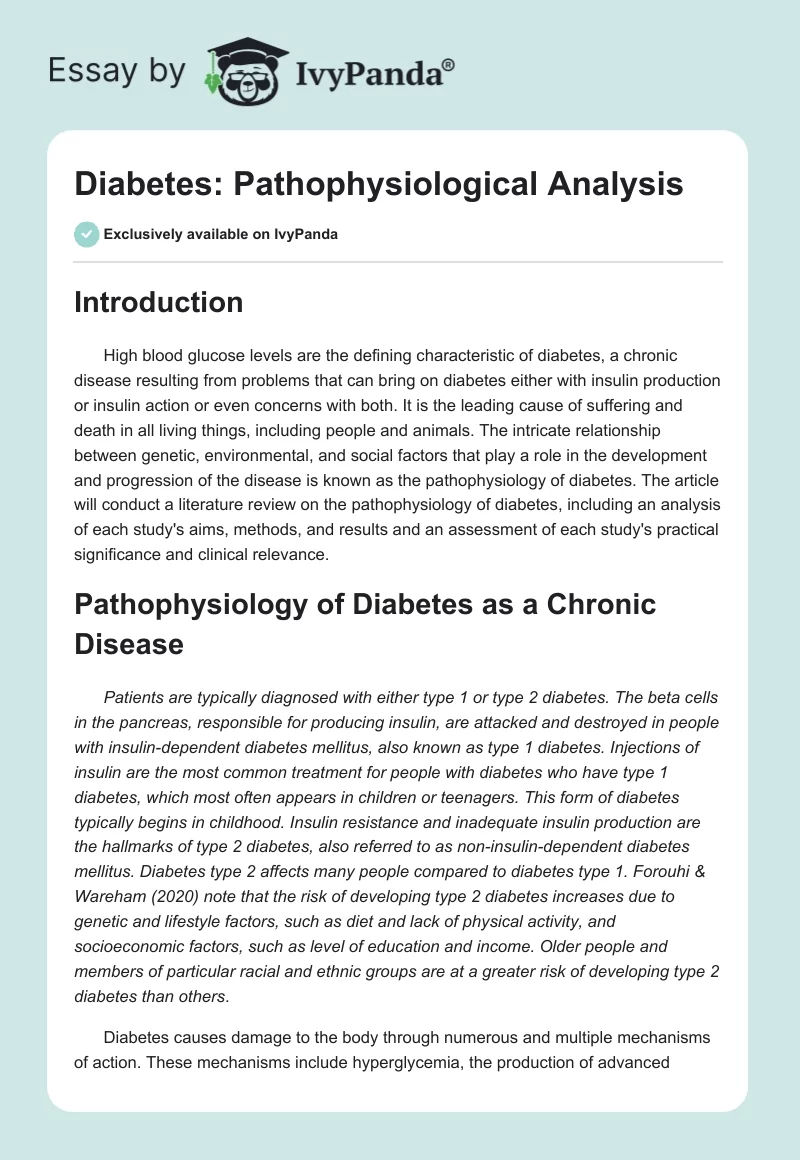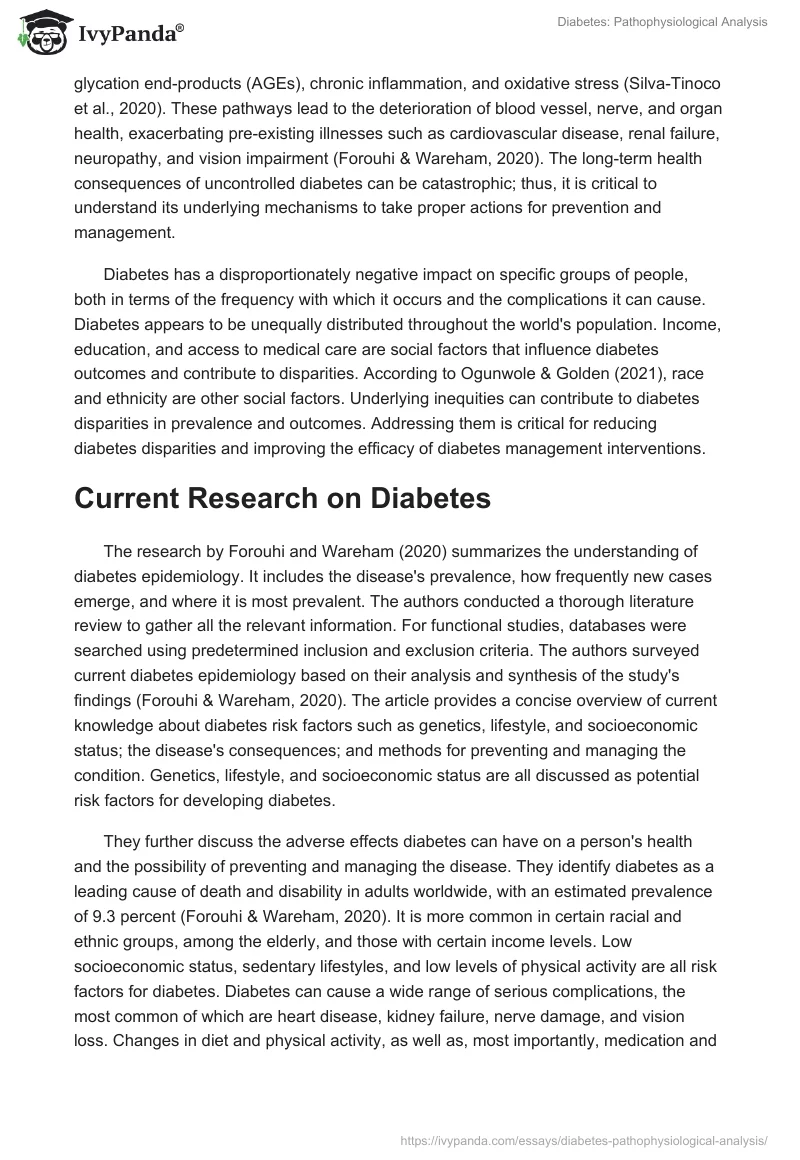Introduction
High blood glucose levels are the defining characteristic of diabetes, a chronic disease resulting from problems that can bring on diabetes either with insulin production or insulin action or even concerns with both. It is the leading cause of suffering and death in all living things, including people and animals. The intricate relationship between genetic, environmental, and social factors that play a role in the development and progression of the disease is known as the pathophysiology of diabetes. The article will conduct a literature review on the pathophysiology of diabetes, including an analysis of each study’s aims, methods, and results and an assessment of each study’s practical significance and clinical relevance.
Pathophysiology of Diabetes as a Chronic Disease
Patients are typically diagnosed with either type 1 or type 2 diabetes. The beta cells in the pancreas, responsible for producing insulin, are attacked and destroyed in people with insulin-dependent diabetes mellitus, also known as type 1 diabetes. Injections of insulin are the most common treatment for people with diabetes who have type 1 diabetes, which most often appears in children or teenagers. This form of diabetes typically begins in childhood. Insulin resistance and inadequate insulin production are the hallmarks of type 2 diabetes, also referred to as non-insulin-dependent diabetes mellitus. Diabetes type 2 affects many people compared to diabetes type 1. Forouhi & Wareham (2020) note that the risk of developing type 2 diabetes increases due to genetic and lifestyle factors, such as diet and lack of physical activity, and socioeconomic factors, such as level of education and income. Older people and members of particular racial and ethnic groups are at a greater risk of developing type 2 diabetes than others.
Diabetes causes damage to the body through numerous and multiple mechanisms of action. These mechanisms include hyperglycemia, the production of advanced glycation end-products (AGEs), chronic inflammation, and oxidative stress (Silva-Tinoco et al., 2020). These pathways lead to the deterioration of blood vessel, nerve, and organ health, exacerbating pre-existing illnesses such as cardiovascular disease, renal failure, neuropathy, and vision impairment (Forouhi & Wareham, 2020). The long-term health consequences of uncontrolled diabetes can be catastrophic; thus, it is critical to understand its underlying mechanisms to take proper actions for prevention and management.
Diabetes has a disproportionately negative impact on specific groups of people, both in terms of the frequency with which it occurs and the complications it can cause. Diabetes appears to be unequally distributed throughout the world’s population. Income, education, and access to medical care are social factors that influence diabetes outcomes and contribute to disparities. According to Ogunwole & Golden (2021), race and ethnicity are other social factors. Underlying inequities can contribute to diabetes disparities in prevalence and outcomes. Addressing them is critical for reducing diabetes disparities and improving the efficacy of diabetes management interventions.
Current Research on Diabetes
The research by Forouhi and Wareham (2020) summarizes the understanding of diabetes epidemiology. It includes the disease’s prevalence, how frequently new cases emerge, and where it is most prevalent. The authors conducted a thorough literature review to gather all the relevant information. For functional studies, databases were searched using predetermined inclusion and exclusion criteria. The authors surveyed current diabetes epidemiology based on their analysis and synthesis of the study’s findings (Forouhi & Wareham, 2020). The article provides a concise overview of current knowledge about diabetes risk factors such as genetics, lifestyle, and socioeconomic status; the disease’s consequences; and methods for preventing and managing the condition. Genetics, lifestyle, and socioeconomic status are all discussed as potential risk factors for developing diabetes.
They further discuss the adverse effects diabetes can have on a person’s health and the possibility of preventing and managing the disease. They identify diabetes as a leading cause of death and disability in adults worldwide, with an estimated prevalence of 9.3 percent (Forouhi & Wareham, 2020). It is more common in certain racial and ethnic groups, among the elderly, and those with certain income levels. Low socioeconomic status, sedentary lifestyles, and low levels of physical activity are all risk factors for diabetes. Diabetes can cause a wide range of serious complications, the most common of which are heart disease, kidney failure, nerve damage, and vision loss. Changes in diet and physical activity, as well as, most importantly, medication and insulin, are all required components in the treatment of diabetes, which necessitates a combination of pharmaceutical and therapeutic approaches.
Nagar et al. (2021) examined the relationship between poverty and racial/ethnic/genetic differences in the incidence of type 2 diabetes in the United Kingdom. Information on the genetic makeup and demographics of a sizable population was obtained from the UK Biobank and used in the study. Participants were categorized according to their socioeconomic status and their genetic ancestry. Among ethnic groups in the United Kingdom, the study found that the incidence of diabetes was significantly higher in those with lower levels of education and a higher proportion of people of African, Asian, and Middle Eastern descent. For instance, the increased risk of diabetes for Afro-Caribbean and South Asian ancestries was more pronounced among economically disadvantaged people. In contrast, Nagar et al. (2021) established that the protective effect of ancestries like European and Chinese against diabetes was less pronounced. The study concludes by stressing the importance of considering the reciprocal relationship between the two factors when devising interventions to lessen disparities.
Galicia-Garcia et al. (2020) investigate how genetic, environmental, and lifestyle factors play a role in the development, maintenance, and progression of type 2 diabetes mellitus. For their study, they carried out a literature review on the investigation of type 2 diabetes and searched PubMed and Scopus using keywords and inclusion/exclusion criteria to find relevant studies (Galicia-Garcia et al., 2020). The primary studies included in the review employed a variety of research methodologies, including observational studies, randomized controlled trials, and other approaches (Galicia-Garcia et al., 2020). Insulin resistance, beta cell dysfunction, and inflammation are named as potential causes of type 2 diabetes by Galicia-Garcia et al. (2020), who also discuss potential treatments for the condition. Medication, surgical intervention, and behavioral therapy are the primary treatment modalities for type 2 diabetes (Galicia-Garcia et al., 2020). They concluded that it is necessary to have an understanding of the pathophysiology of type 2 diabetes in order to develop interventions for management and prevention that are both targeted and effective.
Public Health Application
Several of the Centers for Disease Control and Prevention’s (CDC) 10 Essential Public Health Services are connected to research on diabetes disease surveillance. In order to improve public health, the study’s findings are used to guide initiatives that aim to lower disease prevalence, raise the prevalence of healthy lifestyle choices, and increase access to high-quality healthcare. Galicia-Garcia et al. (2020), Forouhi and Wareham (2020), and Nagar et al. (2021) conducted studies on the pathophysiology and management of diabetes. These studies have important lessons for public health policy, programs, and practice (2020). In order to improve diabetes prevention and management strategies and address social determinants of health that contribute to the persistence of diabetes-related health disparities, the results of these studies are crucial. Inflammation, insulin resistance, beta cell dysfunction, and dietary and lifestyle factors were all studied by Galicia-Garcia et al. in 2020. The information can be used to create targeted interventions for the management and prevention of type 2 diabetes, as well as to guide public health initiatives that encourage healthy lifestyle choices like regular exercise and a balanced diet to ward off or postpone the onset of the condition.
A similar point is made by Nagar et al. (2021), who emphasize the importance of considering multiple factors when managing diabetes. This data can help public health programs that take a comprehensive approach to diabetes care, including lifestyle changes, medication management, and social support. However, Forouhi and Wareham’s (2020) research emphasizes the importance of multiple risk factors in the onset of diabetes, including genetics, lifestyle, and socioeconomic status. This data can be incorporated into public health policies and programs to address these risk factors and advance health equity. Such policies and programs include those aimed at increasing people’s opportunities to engage in physical activity and eat healthily, as well as addressing social and economic factors that affect people’s health, such as educational and employment opportunities. Furthermore, Forouhi and Wareham (2020) emphasize the importance of diabetes prevention and management of the disease. Public health programs can benefit from this information by incorporating lifestyle changes, medication management, and social support into their diabetes care plans.
Conclusion
In conclusion, complications from diabetes include the leading causes of death and disability among adults worldwide. Several researchers have tackled the issue of this disease and found several public health programs that are crucial in treating and controlling this illness. The most recent study and its crucial findings for disease management have been unequivocally identified in this research thorough investigation. This study is vital in ensuring substantial steps are taken to deal with the diabetes menace by highlighting the key findings of the various research.
References
Forouhi, N. G., & Wareham, N. J. (2020). Epidemiology of diabetes. Medicine, 47(1), 22–27. Web.
Galicia-Garcia, U., Benito-Vicente, A., Jebari, S., Larrea-Sebal, A., Siddiqi, H., Uribe, K. B., Ostolaza, H., & Martín, C. (2020). Pathophysiology of type 2 diabetes mellitus. International Journal of Molecular Sciences, 21(17), 6275. Web.
Nagar, S. D., Nápoles, A. M., Jordan, I. K., & Mariño-Ramírez, L. (2021). Socioeconomic deprivation and genetic ancestry interact to modify type 2 diabetes ethnic disparities in the United Kingdom. EClinicalMedicine, 37, 100960. Web.
Ogunwole, S. M., & Golden, S. H. (2020). Social Determinants of health and structural inequities—root causes of diabetes disparities. Diabetes Care, 44(1), 11–13. Web.
Silva-Tinoco, R., Cuatecontzi-Xochitiotzi, T., De la Torre-Saldaña, V., León-García, E., Serna-Alvarado, J., Guzmán-Olvera, E., Cabrera, D., Gay, J. G., & Prada, D. (2020). Role of social and other determinants of health in the effect of a multicomponent integrated care strategy on type 2 diabetes mellitus. International Journal for Equity in Health, 19(1). Web.


